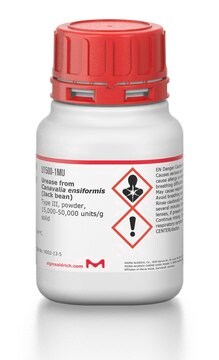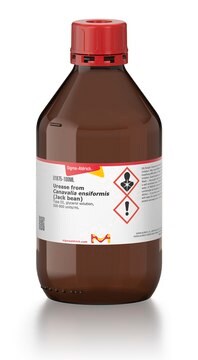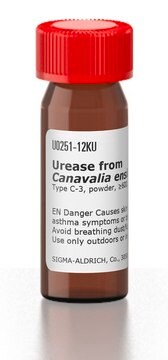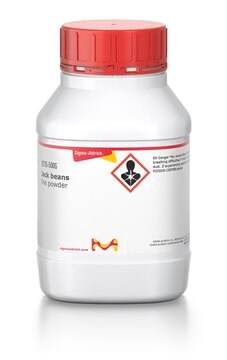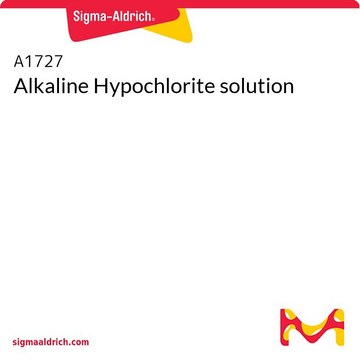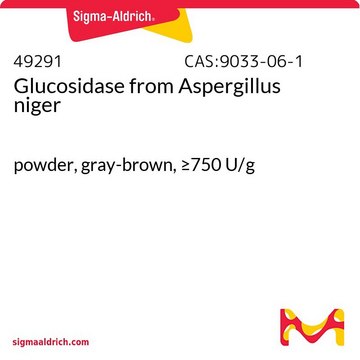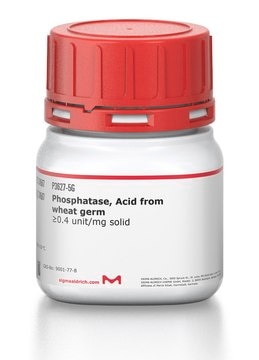U3383
Urease Buffer Reagent
Synonim(y):
Urea colorimetric determination assay reagent
Zaloguj sięWyświetlanie cen organizacyjnych i kontraktowych
About This Item
Kod UNSPSC:
12352204
NACRES:
NA.54
Polecane produkty
opis
When reconstituted, product is a solution of urease from Jack bean in 27 mM EDTA with 0.1% sodium azide as a preservative.
Poziom jakości
Formularz
powder
masa cząsteczkowa
545 kDa
temp. przechowywania
2-8°C
Opis ogólny
Urease is a 545 kDa protein critical for the hydrolysis of urea to carbon dioxide and ammonia.
Urease is a dinickel enzyme that hydrolyses urea into ammonia and carbon dioxide. It is secreted by several bacterial species, invertebrates, fungi, and plants. Detection of urease activity is a potential diagnostic tool for Helicobacter pylori infections and several oral bacterial infections. two Ni2+ ions bridged by a hydroxyl group and a carbamylated lysine.
Zastosowanie
Urease Buffer Reagent has been used:
- to measure plasma urea N (PUN) by the hypochlorite-phenol nitroprusside method
- in cell viability assay to measure the synthesis of urea in human fetal stem/progenitor cells
- to study the metabolic capacity of rat hepatocytes
Used in conjunction with Phenol Nitroprusside solution (Product Code P 6994) and Alkaline Hydpochlorite solution (Product Code A 1727) for the colorimetric determination of urea.
Ta strona może zawierać tekst przetłumaczony maszynowo.
Hasło ostrzegawcze
Danger
Zwroty wskazujące rodzaj zagrożenia
Zwroty wskazujące środki ostrożności
Klasyfikacja zagrożeń
Eye Irrit. 2 - Resp. Sens. 1 - Skin Irrit. 2
Kod klasy składowania
13 - Non Combustible Solids
Klasa zagrożenia wodnego (WGK)
WGK 1
Temperatura zapłonu (°F)
Not applicable
Temperatura zapłonu (°C)
Not applicable
Środki ochrony indywidualnej
Eyeshields, Faceshields, Gloves, type ABEK (EN14387) respirator filter
Wybierz jedną z najnowszych wersji:
Masz już ten produkt?
Dokumenty związane z niedawno zakupionymi produktami zostały zamieszczone w Bibliotece dokumentów.
Klienci oglądali również te produkty
Cristian Follmer
Phytochemistry, 69(1), 18-28 (2007-08-21)
The broad distribution of ureases in leguminous seeds, as well as the accumulation pattern of the protein during seed maturation, are suggestive of an important physiological role for this enzyme. Since the isolation and characterization of jack bean urease by
Kang Cheng et al.
Hepatology (Baltimore, Md.), 50(4), 1194-1203 (2009-07-29)
Tracking stem/progenitor cells through noninvasive imaging is a helpful means of assessing the targeting of transplanted cells to specific organs. We performed in vitro and in vivo studies wherein adult human hepatocytes and human fetal liver stem/progenitor cells were labeled
Yuta Enami et al.
Hepatology (Baltimore, Md.), 55(4), 1182-1192 (2011-10-14)
Organs from non-heart-beating donors are attractive for use in cell therapy. Understanding the nature of molecular perturbations following reperfusion/reoxygenation will be highly significant for non-heart-beating donor cells. We studied non-heart-beating donor rats for global gene expression with Affymetrix microarrays, hepatic
L A Winkelman et al.
Journal of dairy science, 96(12), 7565-7577 (2013-10-15)
This study investigated the effect of 2 different types of long-acting insulin on milk production, milk composition, and metabolism in lactating dairy cows. Multiparous cows (n=30) averaging 88 d in milk were assigned to one of 3 treatments in a
Rukhsana Aslam et al.
Histology and histopathology, 35(12), 1483-1492 (2020-10-31)
To determine the role of the transplantation of bone marrow-derived mesenchymal stem cells (MSCs) in podocyte renewal, we studied BALB/C mice with or without adriamycin-induced acute kidney injury. MSCs were transplanted ectopically under the capsule of the left kidney or
Nasz zespół naukowców ma doświadczenie we wszystkich obszarach badań, w tym w naukach przyrodniczych, materiałoznawstwie, syntezie chemicznej, chromatografii, analityce i wielu innych dziedzinach.
Skontaktuj się z zespołem ds. pomocy technicznej